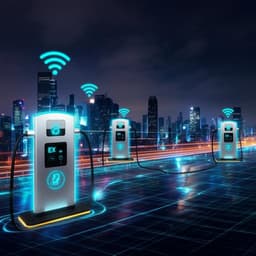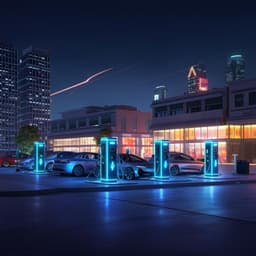
Engineering and Technology
Charging infrastructure access and operation to reduce the grid impacts of deep electric vehicle adoption
S. Powell, G. V. Cezar, et al.
Electric vehicles are transforming the energy landscape, but how will they impact our electricity grids? Join researchers Siobhan Powell, Gustavo Vianna Cezar, Liang Min, Inês M. L. Azevedo, and Ram Rajagopal as they explore innovative charging strategies and their implications for grid operations in the face of rapid EV adoption in the US Western Interconnection.
~3 min • Beginner • English
Introduction
Electric vehicles (EVs) are poised to expand rapidly and, coupled with a decarbonizing grid, can help the United States meet emissions reduction targets. However, large-scale EV charging links transportation and electricity systems that are transforming largely independently, creating uncertain grid impacts at deep adoption levels. Driver charging behaviour is heterogeneous and stochastic, and charging access and controls can reshape load profiles. Prior assessments often consider low adoption levels, limited infrastructure scenarios, or centralized idealized controls, leaving open the question of how infrastructure access and realistic controls affect generation-level impacts in a high-renewables 2035 grid. This study investigates how combinations of charging infrastructure access (particularly home versus daytime/workplace access), driver behaviour, and commonly implemented charging controls shape charging demand and influence grid capacity, net demand peaks, storage needs, ramping, use of non-fossil fuel generation, costs, and emissions across the WECC region under deep EV adoption (50% and 100%). The aim is to identify charging strategies and infrastructure build-outs that minimize adverse grid impacts and support effective decarbonization.
Literature Review
Existing modelling approaches frequently impute future charging patterns from early adopters or rely on assumptions about driver behaviour, and many studies focus on near-term adoption or current grid conditions. Numerous works demonstrate that managed charging can reduce costs and mitigate impacts; however, most: (1) consider limited charging access scenarios (often emphasizing home charging among early adopters), (2) employ centralized optimization rather than site-by-site or rate-driven strategies reflective of actual implementations, (3) omit storage and emissions calculations, or (4) under-explore how infrastructure availability itself acts as a lever to shift charging in time and space. Other studies emphasize infrastructure for long-distance travel and high-energy days rather than daily charging integration. There remain gaps in understanding system consequences at deep adoption levels and in conceptualizing infrastructure build-out as a form of charging control to align charging with renewable generation.
Methodology
The study models daily EV charging demand and grid operations for 2035 in the US portion of the Western Interconnection (WECC; 11 states, >75 million people). Charging demand: A probabilistic, data-driven model captures diverse driver behaviours using 2.8 million sessions from 27.7 thousand BEV drivers (San Francisco Bay Area, 2019). Driver behaviour clusters are linked to county-level demographics (housing type, income), access to charging (home, workplace), vehicle battery size (probabilistic by income), and annual energy needs (derived from mileage distributions assuming 5 miles/kWh). For each WECC county, the model samples session start times, energies, and segments (SFH L2, MUD L1/L2, workplace L2, public L2, DCFC) to produce minute-resolution uncontrolled weekday/weekend profiles, concatenated to form an annual load. Infrastructure access scenarios: four access cases define home and workplace availability—Universal Home, High Home, Low Home–High Work, Low Home–Low Work—based on California surveys and commute data. In Universal Home, ~86% of consumption occurs at home; in Low Home access, ~22% at home. Control strategies: commonly implemented controls are modelled—residential SFH timers at 9 p.m. and 12 a.m. (reflecting EV TOU rates), randomized SFH timers (start times uniformly distributed on half-hours from 8 p.m.–2:30 a.m.), and workplace load modulation (site-level uni-directional control) with two objectives: peak minimization (demand charge-oriented) and average emissions minimization (using average emissions profiles). Workplace control is emulated via a data-driven mapping from uncontrolled to controlled profiles trained on 1,000 simulated site-days (150 vehicles/site). Adoption levels: impacts are evaluated at 50% EV adoption (24 million EVs in WECC) and 100% (stress test); sensitivities span 10–100%. Baseline non-transport electrification increases 2035 demand by 16% (relative to 2019); each 1% EV adoption adds ~0.11% to total consumption. Grid model: A reduced-order merit-order dispatch model (extended from Deetjen & Azevedo) represents 2035 WECC with announced retirements/additions (−17,175 MW coal; −7,644 MW gas; +14,283 MW gas), scaled baseline demand (Electrification Futures Study), increased renewables (Medium: solar 3.5×, wind 3× 2019; High: solar 5×, wind 5×), and 10 GW 4-hour grid storage that smooths net demand. Non-fossil generation (nuclear, hydro, wind, solar) is dispatched first; net demand determines combustion fleet dispatch. Additional storage requirements are computed as the minimum 4-hour capacity needed to supply unmet demand (assumed charged by additional solar). Emissions are calculated hour-by-hour from dispatched generators; added EV emissions are the difference versus a no-EV scenario. Metrics: peak total and net demand magnitudes and timing; maximum EV-supportable adoption before capacity shortfalls; minimum storage requirements; fossil ramping (max 1-hour ramp); excess non-fossil generation (curtailment/export proxy); CO2 g/mile for EV charging; sensitivity to ±10% changes in coal/gas/wind/solar capacities, fuel prices (supplement), battery size and fast-charging prevalence.
Key Findings
• Electricity consumption: Each 1% EV adoption raises total consumption by ~0.11%. With 50% adoption, EVs add ~5% over the 2035 baseline; combined with other electrification, demand rises up to ~22% over 2019. At 100%, EVs add ~11% and total up to ~28% over 2019.
• Peak total demand: Baseline 2035 weekday peak without EVs ≈109 GW at 5 p.m. With 50% EVs, peak total increases by ~3–9% depending on scenario; with 100%, by ~9–26%. High home charging shifts peaks later; daytime charging introduces mid-morning peaks.
• Net demand impacts: Daytime charging scenarios produce the lowest increases in peak net demand; home-centric charging is worst. Peak net demand remains in the evening across all scenarios due to solar profiles. Business As Usual (BAU) increases typical peak net demand 1.6× more than Low Home–High Work at 50% EVs (1.8× at 100%). Worst case—Universal Home with 9 p.m. timers—raises peak net demand by ~3.3–3.4×.
• Storage requirements and capacity limits: With 10 GW storage, the grid can support at least 50% EV adoption. More EVs are supportable in Low Home access scenarios. Minimum storage needed varies widely by scenario: at 50% EVs, ~3.9–7.4 GW (1.9× spread); at 100% EVs, ~7.4–24.5 GW (3.3× spread). Best case (Low Home–High Work, uncontrolled): ~4.2 GW at 50% and ~8.1 GW at 100% (≈3.6% and 6.1% of typical peak total demand, respectively). Worst case (Universal Home + 9 p.m. timers) limits maximum supportable EVs to ~59% without adding generation beyond 10 GW storage. Midnight or randomized SFH timers raise Universal Home capacity from ~67% to ~86% and ~83%, respectively.
• Ramping and excess non-fossil generation: With 10 GW storage operating, adding EVs reduces fossil ramping in daytime-charging scenarios (flatter net demand) and increases ramping with high home charging (alignment with evening peaks). Excess non-fossil generation (pre-EV ≈2.8 TWh) decreases with more EVs in all scenarios, fastest with daytime charging (e.g., BAU: ~1.3 TWh at 50% EVs, ~0.5 TWh at 100%).
• Emissions: EV charging emissions are substantially lower than ICE tailpipe emissions. In 2035 Medium Renewables, EV CO2 is ~84–88 g/mile at 50% EVs and ~89–93 g/mile at 100% EVs (vs ~404 g/mile average ICE). Scenarios with less home charging have lower g/mile; spread between best and worst is ~5.0% at 50% and ~4.5% at 100% in Medium Renewables, and ~36% and ~23% in High Renewables. Workplace average-emissions minimization control yields little improvement over uncontrolled daytime charging due to misalignment between average and marginal emissions.
• Controls: Common timer controls can exacerbate evening net demand peaks and drive large storage needs at deep adoption; workplace peak minimization can increase late-afternoon net demand where baseline demand is high. Random or midnight timers are less harmful than synchronized 9 p.m. timers but still inferior to shifting access toward daytime charging.
• Sensitivity: Main conclusions are robust to ±10% changes in coal/gas/wind/solar capacities; added wind/solar improve emissions (especially with daytime charging). A 10% increase in gas/coal capacity can eliminate additional storage need to cover charging at 50% EV adoption (acting like peakers).
Discussion
The study demonstrates that, in a high-renewables 2035 WECC grid, the timing of EV charging dominates its generation-level impacts. Aligning charging with daytime solar (via increased daytime access) consistently reduces peak net demand, storage requirements, fossil ramping, excess non-fossil energy, and CO2 per mile relative to home-centric charging. Conversely, widely used practices—synchronized evening timers and workplace peak minimization—can shift demand into stressed hours, worsening net demand peaks and storage needs. These findings directly answer the research question by identifying infrastructure access (a multi-year planning lever) as a more powerful, robust tool than commonly implemented controls for integrating EV load. Policy implications include: prioritizing deployment of convenient, low-cost, open-access daytime charging (workplaces, public destinations), designing rates that reflect generation-level conditions (and possibly vary day by day), and coordinating distribution- and generation-level objectives to avoid site-level incentives that increase system-wide peaks. While emissions reductions between charging scenarios are modest under medium renewables, the avoided storage requirements are substantial and free storage to provide reliability and ancillary services. The results also highlight that optimal strategies may vary in systems with different resource profiles (e.g., high overnight wind), underscoring the need to couple charging strategies with local grid conditions.
Conclusion
By combining a behaviourally realistic EV charging model with a 2035 WECC dispatch model, the paper shows that expanding daytime charging access and reducing reliance on home-centric evening charging substantially improves grid integration at deep EV adoption. Daytime charging lowers evening net demand peaks, reduces required grid-scale storage, decreases fossil ramping, utilizes more non-fossil generation, and lowers EV charging emissions per mile. Common timer-based residential controls and workplace peak minimization, as implemented today, can create severe generation-level impacts at high adoption. Policymakers and utilities should coordinate infrastructure build-out and rate design to shift charging from home to daytime, incorporate generation-level impacts into tariffs, and consider centralized/utility controls that adapt to daily grid conditions. Future research should evaluate trade-offs between distribution and generation objectives, explore systems with different renewable and load profiles (e.g., overnight wind, seasonal effects), extend to medium- and heavy-duty vehicles, and assess dynamic rate structures and advanced controls that account for marginal emissions variability.
Limitations
The analysis assumes the distribution system can handle aggregate demand and does not model transmission constraints or congestion; excess non-fossil generation is treated as curtailment/export without network modelling. Renewable generation profiles are scaled from 2019 and may differ from future installations. Storage operation is simplified (baseline 10 GW for smoothing; additional 4-hour storage sized to cover unmet demand and assumed charged by added solar without iterative re-dispatch). Only personal light-duty vehicles are modelled; commercial medium/heavy-duty fleets are excluded. Annual charging demand is constructed by repeating typical weekday/weekend profiles, neglecting seasonal temperature effects. Driver behaviour is calibrated with Bay Area data (2019) and extrapolated across WECC using probabilistic mappings; actual future behaviours and access may differ. Results are sensitive to future baseline demand, resource mixes, and fuel prices; in systems with different temporal generation profiles (e.g., high overnight wind), nighttime charging could be preferable.
Related Publications
Explore these studies to deepen your understanding of the subject.







